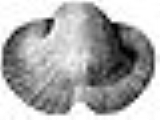
Bellerophontidae
Overview
Family (biology)
In biological classification, family is* a taxonomic rank. Other well-known ranks are life, domain, kingdom, phylum, class, order, genus, and species, with family fitting between order and genus. As for the other well-known ranks, there is the option of an immediately lower rank, indicated by the...
of specialized globose bellerophontids
Bellerophontoidea
The Bellerophontoidea, , common name "bellerophonts", is a superfamily of extinct planospirally coiled globose molluscs, generally included in the Gastropoda that first appeared late in the Cambrian and continued until late in the Triassic.-Biology:Unlike normal gastropods, the shells of...
; Paleozoic and Early Triassic mollusks
Mollusca
The Mollusca , common name molluscs or mollusksSpelled mollusks in the USA, see reasons given in Rosenberg's ; for the spelling mollusc see the reasons given by , is a large phylum of invertebrate animals. There are around 85,000 recognized extant species of molluscs. Mollusca is the largest...
of uncertain position (Gastropoda
Gastropoda
The Gastropoda or gastropods, more commonly known as snails and slugs, are a large taxonomic class within the phylum Mollusca. The class Gastropoda includes snails and slugs of all kinds and all sizes from microscopic to quite large...
or Monoplacophora
Monoplacophora
Monoplacophora, meaning "bearing one plate", is a polyphyletic class of mollusks with a cap-like shell, living on the bottom of deep sea. Extant representatives were unknown until 1952; previously they were known only from the fossil record.- Definition :...
).
These mollusks appeared in the Late Cambrian
Cambrian
The Cambrian is the first geological period of the Paleozoic Era, lasting from Mya ; it is succeeded by the Ordovician. Its subdivisions, and indeed its base, are somewhat in flux. The period was established by Adam Sedgwick, who named it after Cambria, the Latin name for Wales, where Britain's...
and continued until the Early Triassic
Triassic
The Triassic is a geologic period and system that extends from about 250 to 200 Mya . As the first period of the Mesozoic Era, the Triassic follows the Permian and is followed by the Jurassic. Both the start and end of the Triassic are marked by major extinction events...
.
The shell resembles a miniature Nautilus
Nautilus
Nautilus is the common name of marine creatures of cephalopod family Nautilidae, the sole extant family of the superfamily Nautilaceae and of its smaller but near equal suborder, Nautilina. It comprises six living species in two genera, the type of which is the genus Nautilus...
, with greatly overlapping, rounded whorls
Whorl (mollusc)
A whorl is a single, complete 360° revolution or turn in the spiral growth of a mollusc shell. A spiral configuration of the shell is found in of numerous gastropods, but it is also found in shelled cephalopods including Nautilus, Spirula and the large extinct subclass of cephalopods known as the...
, in which the last whorl
Body whorl
Body whorl is part of the morphology of a coiled gastropod mollusk.- In gastropods :In gastropods, the body whorl, or last whorl, is the most recently-formed and largest whorl of a spiral or helical shell, terminating in the aperture...
completely encompasses the others, leaving either a very narrow umbilicus on either side, or none at all.

